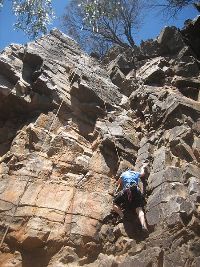Interactions
 Research was done to study the effects of rock climbing on
the density, richness, diversity, and community composition of
snails on the Niagara Escarpment in southern Ontario, Canada.
The cliffs of the Niagara Escarpment provide habitat for
extremely diverse communities of land snails that may be at risk
as a result of recreational rock climbing. This includes the
Vertigo bollesiana alongside twenty-four other species that were
studied in the survey. Studies were performed on randomly
selected climbed and unclimbed sections of cliffs on the plateau
(cliff edge), cliff face, and talus (cliff base). Snail density,
richness, and diversity were lower along climbing routes than in
unclimbed areas, and community composition differed between
climbed and unclimbed samples. These results suggest that rock
climbing has significant negative effects on all aspects of the
snail community on cliffs; therefore, it’s recommended the
inclusion of gastropods in conservation plans for protected
areas containing cliffs (Larson,
McMillan, Nekola, 2003).
Research was done to study the effects of rock climbing on
the density, richness, diversity, and community composition of
snails on the Niagara Escarpment in southern Ontario, Canada.
The cliffs of the Niagara Escarpment provide habitat for
extremely diverse communities of land snails that may be at risk
as a result of recreational rock climbing. This includes the
Vertigo bollesiana alongside twenty-four other species that were
studied in the survey. Studies were performed on randomly
selected climbed and unclimbed sections of cliffs on the plateau
(cliff edge), cliff face, and talus (cliff base). Snail density,
richness, and diversity were lower along climbing routes than in
unclimbed areas, and community composition differed between
climbed and unclimbed samples. These results suggest that rock
climbing has significant negative effects on all aspects of the
snail community on cliffs; therefore, it’s recommended the
inclusion of gastropods in conservation plans for protected
areas containing cliffs (Larson,
McMillan, Nekola, 2003).
This can be explained because the ledges and cracks in the vertical rock surface that are the primary habitat for cliff land snails are also the primary means by which climbers ascend the cliff face. The use of these microsites for hand and foot holds causes removal of the firm soil and organic matter, thereby decreasing the amount and quality of available habitat for snails. In some instances, climbers purposefully remove soil to increase the security of the hold and to reduce the chance of slipping (Larson, McMillan, Nekola, 2003). To read more follow this link.

chart displaying the effect of rock climbing in snail habitats